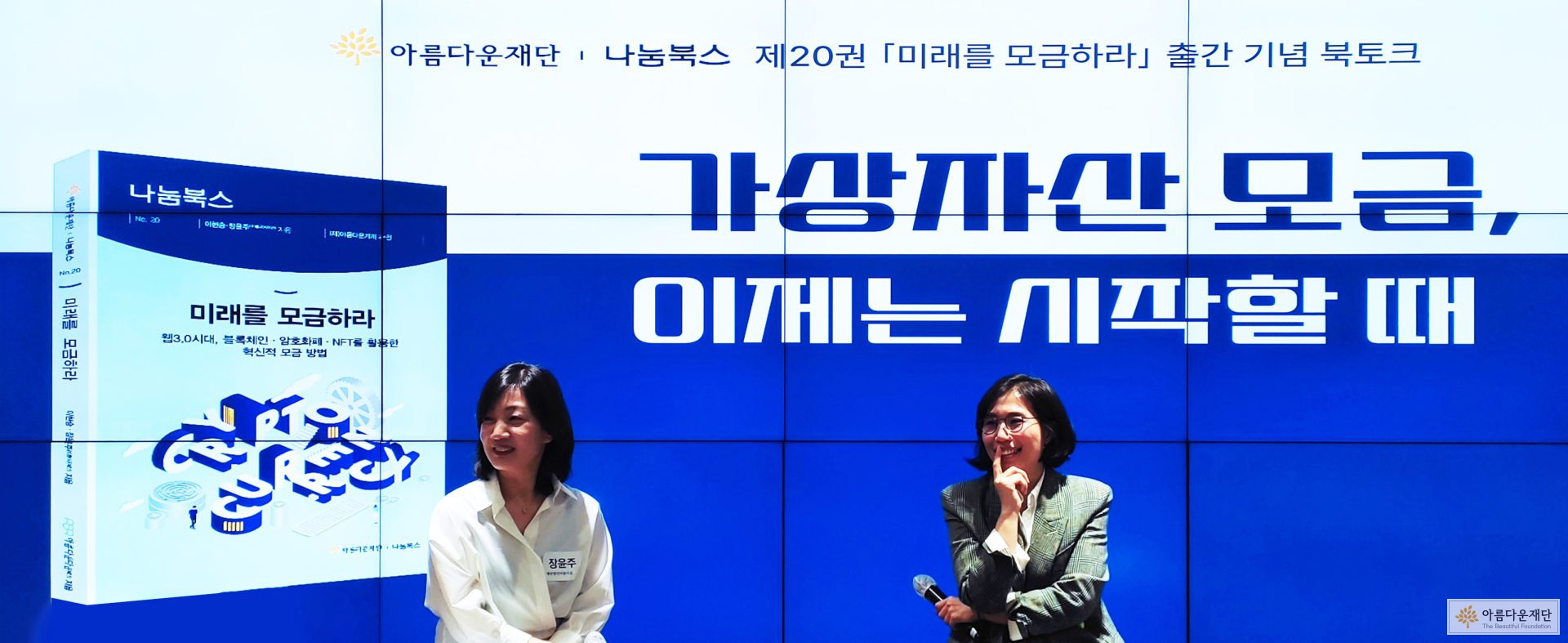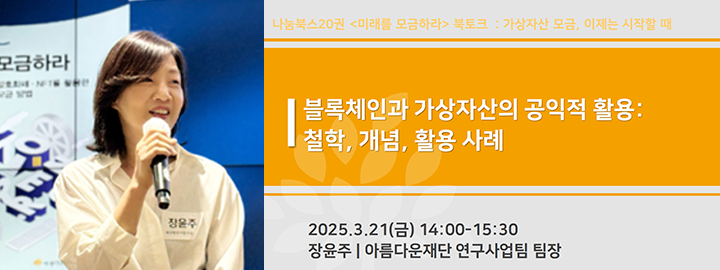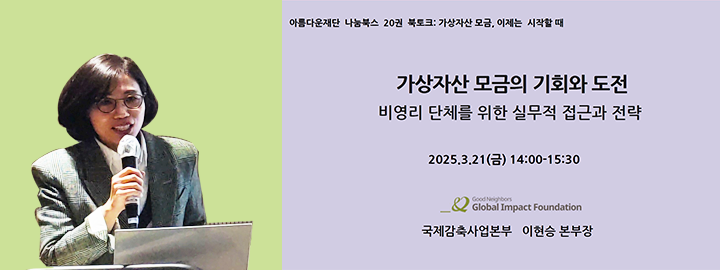Book Talk for the 20th Volume of Nanum Books, Fundraising for the Future
Center on Philanthropy at The Beautiful Foundation has been publishing the Nanum Books series since 2001 to enhance expertise and ethics across the nonprofit sector. The series aims to strengthen the capabilities of professionals, produce and distribute knowledge, and promote public awareness of giving.
The newly released Fundraising for the Future(Korean) is the first book in Korea to address fundraising with crypto assets. To commemorate its publication and to share insights, knowledge, and best practices on this increasingly relevant topic, the center hosted a book talk with two authors.
The event took place on Friday, March 21st, from 2 PM at the Multipurpose Hall of the Seoul Public Interest Activities Support Center. Over 70 people, including fundraisers, nonprofit practitioners, and professionals from the crypto asset industry participated. The discussion provided a meaningful opportunity for the authors and attendees to share experiences, case studies, and challenges related to adopting crypto asset fundraising.

Blockchain and Crypto Assets for Public Good
Philosophy, Concepts, and Use Cases
Jang, Yoon Joo | Head of Research Project Team at The Beautiful Foundation

First, I would like to express my gratitude to former team head Lee Young-ju, who encouraged me to write this book, as well as to research fellow Shin Sung-gyu, who managed the planning and publication. I also thank Director Kim and Secretary-General Kim of The Beautiful Foundation for supporting the book’s publication and deciding to implement a system for accepting crypto asset donations. Additionally, I extend my appreciation to the Beautiful Store for funding the Nanum Books series through proceeds from The Beautiful Bookstore, and to my co-author and dear friend, Lee Hyun Seung.
My interest in crypto asset donations began when I received a call asking, “Can cryptocurrency be donated?” This curiosity led to research that resulted in the 2022 report and ultimately culminated in this book.
Blockchain and cryptocurrency are often perceived as unrelated to public interest activities, viewed instead as purely technological or investment tools. However, the fundamental philosophy behind blockchain aligns closely with the mission of nonprofit and public interest activities. That is why I want to begin by discussing the philosophy of blockchain. (For further details, refer to the slides below. It is only available in Korean.)
Download: Blockchain and Crypto Assets for Public Good (in Korean)
Opportunities and Challenges of Crypto Asset Fundraising
A Practical Approach and Strategy for Nonprofit Organizations
Lee Hyun Seung | Director of Global Mitigation Group at Good Neighbors Global Impact Foundation

I never imagined I would become an author, yet here I am, standing in front of you all as the co-author of Fundraising for the Future. Many people contributed to making this book a reality, and while Yoon Joo has already extended her thanks, I would also like to express my gratitude.
Fundraising with crypto assets is not easy. However, as global challenges grow more complex and large-scale, solving them requires significant funding. This necessitates exploring new sources of revenue. The speed of change does not wait for us, and there are many reasons why we cannot overlook crypto assets as an emerging funding avenue. Today, I want to delve into this topic. (For further details, refer to the presentation slides below. It is only available in Korean.)
Download: Opportunities and Challenges of Crypto Asset Fundraising (in Korean)
Preparing for Crypto Asset Fundraising: Now is the Time to Start
A Conversation with the Authors
How has the landscape of crypto asset fundraising changed since you first conceived and began writing this book three years ago?
Yoon Joo: The change has been both significant and minimal. Over the past three years, there haven’t been many new cases of crypto asset fundraising. However, the recent Financial Services Commission (FSC) decision to allow nonprofit organizations to liquidate cryptocurrency from corporate wallets has sparked a surge of interest, which is an encouraging development.
Hyun Seung: The FSC’s decision has indeed opened new opportunities. However, simply opening a corporate wallet will not automatically increase donations. NPOs still face regulatory constraints, making it difficult to fully leverage blockchain and other emerging technologies. While nonprofits can now liquidate cryptocurrency under their corporate name, other regulatory barriers remain. That’s why now is the time to prepare—by setting up wallets, educating teams, and establishing internal guidelines. If we wait until the regulatory landscape is fully favorable, then we will be too late.
The Beautiful Foundation set up a corporate wallet and launched a fundraising page on The Giving Block. That must have been challenging. Can you share some behind-the-scenes experiences?
Yoon Joo: The biggest challenge was communication in English since The Giving Block is based in the U.S.(haha). There were also regulatory considerations regarding how cryptocurrency would be converted into US dollars and then into Korean won. The foundation had to determine whether we needed to register for donation collection approval or report foreign exchange transactions. The foundation navigated this by drawing parallels with how domestic platforms like Naver Happybean operate, consulting researchers in the field, and discussing with experts who had prior experience.
What legal and institutional improvements are needed to encourage crypto asset donations?
CEO at Korea Digital Assets: When a NPO opens a corporate wallet with a crypto asset exchange and receives cryptocurrency donations, the process is not very different from receiving other assets like stocks. Banks will manage anti-money laundering (AML) compliance, and as long as nonprofits properly assess fair market value for tax reporting, there should be no issues. However, nonprofits should establish clear internal guidelines to ensure consistent valuation. If financial regulatory clarification is needed, organizations should consult with their exchange partners.
Hyun Seung: Disclosure requirements may also need revision. Receiving crypto asset donations could expand the scope of required disclosures. Additionally, since crypto asset donations tend to involve large sums, nonprofits should carefully assess the donor’s identity, the source of funds, and the purpose of the donation—similar to handling major gifts from individuals or corporations. It would be the best for experienced fundraising teams to manage this process.
Why this Book Talk was Valuable
-
I had little knowledge of crypto assets, but this event provided a comprehensive overview of recent trends and future prospects.
-
Hearing from diverse voices—including past nonprofit staff who handled cryptocurrency donations at the Community Chest of Korea, as well as exchange representatives—was incredibly insightful.
-
I strongly agree that now is the time for nonprofits to actively study and take action on crypto asset fundraising.